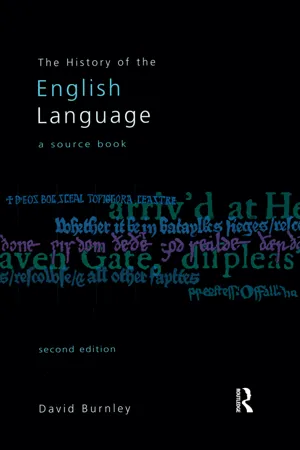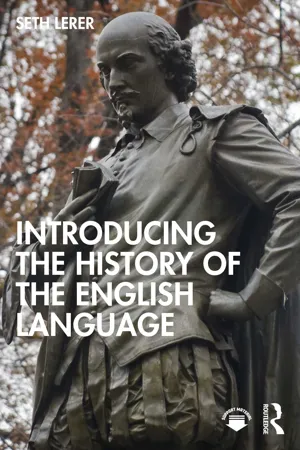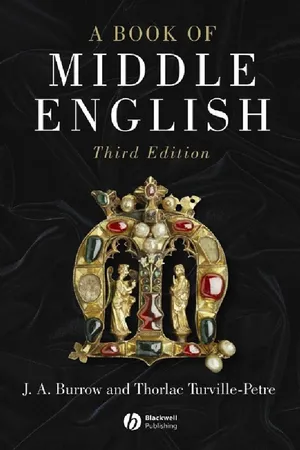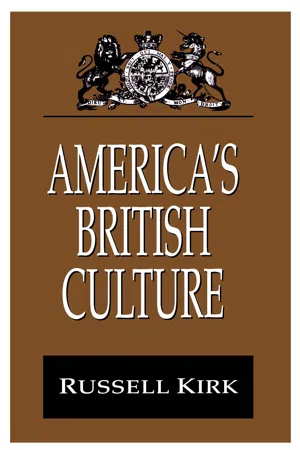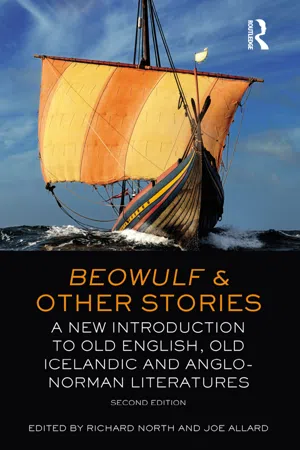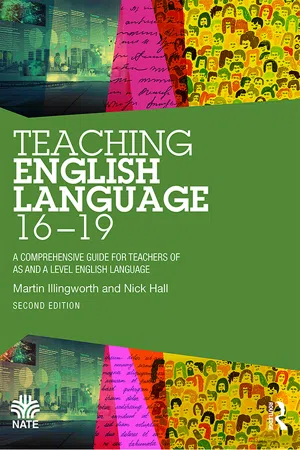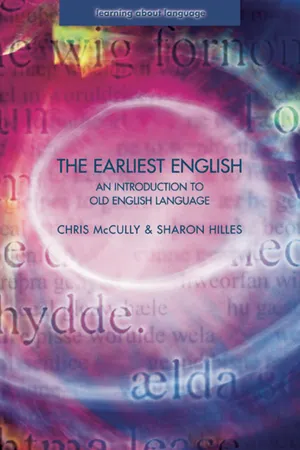Languages & Linguistics
Old English Language
Old English, also known as Anglo-Saxon, was the language spoken in England from around the 5th to the 11th century. It is a Germanic language and is the earliest form of the English language. Old English has a complex grammar and a vocabulary heavily influenced by Germanic and Norse languages. It is written in the runic alphabet and later in the Latin alphabet.
Written by Perlego with AI-assistance
Related key terms
Related key terms
1 of 4
Related key terms
1 of 3
10 Key excerpts on "Old English Language"
- eBook - ePub
The History of the English Language
A Sourcebook
- David Burnley(Author)
- 2014(Publication Date)
- Routledge(Publisher)
Old English (700–1100)
Old English, and Anglo-Saxon, are names used by modern scholars for the written version of a language used in England from the departure of the Romans until some time after the Norman Conquest. Its speakers referred to it as Englisc, the language of the Angles, who were the major ethnic group consistently identified among the Germanic settlers of Britain in early sources. These people must have spoken a language closely similar to that used by other Germanic peoples along the North Sea coast from Denmark to the Rhine, but in a period of some seven centuries following the earliest settlement their language underwent major developments. Direct written evidence of these is available only from the last four hundred years of this evolution, and indeed the vast majority of our information about Old English is preserved in manuscripts written in the tenth and eleventh centuries. Apart from the runic alphabet, which had been used in earlier Germanic society for inscriptions on all kinds of objects, from weapons to standing stones, the earliest speakers of English, despite artistic skills evident in archaeological discoveries like those at Sutton Hoo and from Kentish cemeteries, were both pagan and illiterate. The coming of Christianity in ad 597 introduced Latin literacy to England, which was followed by attempts to render the English language in the letters of the Latin alphabet – those which survive to the present day. Old English forms of the Latin letters in the Hiberno-Saxon script were very different from modern printed forms, as can be seen in the case of the <s> and <r> in the facsimile (p. 21), and in addition Old English used some letters no longer found in English: ‘eth’ <ð> and ‘yogh’ <ʒ> (the latter is usually printed as <g> in modern editions, but is retained in this book to permit a more valid comparison between the spelling systems of Old and Middle English) were derived from Irish Latin, ‘thorn’ <þ> and ‘wynn’ <p> were runes (the latter printed as <w> in modern editions), and the Latin digraph ‘ash’ <æ>. Thorn and eth are equivalent to <th> in the modern spelling system and indeed <th> is not unknown in early Old English. The letters <v>, <z> and <q> were not normally used in Old English texts, and their roles were filled respectively by <f>, <s> and the digraph <cp>. The letter <j> was not used (Scragg 1974 - eBook - ePub
- Seth Lerer(Author)
- 2024(Publication Date)
- Routledge(Publisher)
3 The Old English PeriodDOI: 10.4324/9781003227083-4Old English (OE) describes the Germanic vernacular spoken and written in the British Isles from roughly the middle of the fifth century until the early twelfth century. OE shared features of grammar, sounds, and vocabulary with other early Germanic languages and many modern ones. It was highly inflected, using word endings to determine the relationships among words in a sentence. Nouns had grammatical gender (masculine, feminine, and neuter); they belonged to certain groups or classes (depending on their sound histories of their roots); they were declined in a variety of cases, depending on their grammatical function; and there had to be agreement with adjectives that modified them (that is, similar endings depending on the number, case, and gender of the noun). Verbs were conjugated according to tense and number; verbs were also grouped into classes depending on their sounds and sound histories; and certain verbs formed their tenses by changing the root vowel (strong verbs, such as drink, drank, drunk) and others formed their tenses by adding a suffix (weak verbs, such as live, lived). OE had a distinctive sound (one that has been reconstructed, with reasonable accuracy, by scholars over the past three hundred years) and a distinctive way of forming letters in writing (adapting old runic letters for sounds not found in the Latin alphabet). It was the medium of prayer, scholarship, history, poetry, and philosophy for more than four hundred years.This chapter illustrates the distinctive features of OE and gives students basic reading knowledge of the language so that they may understand its place in English linguistic history and the literary imagination. We will also see how studying OE gives us access to a political and social world, to myth and religion, and to creativity and culture. OE was not a single, static language, however. Over the seven centuries of its use, it changed: new words came in from Latin and Scandinavian languages; word endings appear to have been leveled out or even lost; patterns of word order and particulars of literary style evolved. In addition, OE varied in sound and sense across the British Isles. Scholars have identified four major regional dialects by examining the spelling of words in surviving manuscripts. Old English was the language of kings and agricultural workers, poets and monks. It was a vernacular marked by nuance and variety, depending on the who, when, and where of its use. - eBook - ePub
- David Graddol, Dick Leith, Joan Swann, Martin Rhys, Julia Gillen(Authors)
- 2020(Publication Date)
- Routledge(Publisher)
Englisc ('English') was first used to denote both people and language under his auspices.In the tenth century there was another revival of learning and literary activity, this time associated with the influential Benedictine monasteries. The scriptorium of the monastery at Winchester, producing texts in the West Saxon dialect, seems to have made considerable efforts to regularise spellings and this has been seen as a move in the direction of standardisation in English. (See another book in this series, Graddol et al, 2007, for further discussion of this issue).Most extant Old English manuscripts date from the late Old English period and they preserve, not only translations of learned Latin texts, but also an important body of vernacular literature in prose and poetry. Some of the poems are religious, following the example set by Caedmon, and others (such as Beowulf) stem from inherited Germanic traditions.So far we've looked at Old English: where it came from, what it was like, how certain aspects of it changed, and how the process of change might be explained. We now move on to a different period of the English language, that known as 'Middle English'.2.6 The transition to Middle EnglishWe have seen that the English language was undergoing significant change during the early part of the tenth century. In 1066 an event occurred that was to have a profound effect on this process. In that year a French-speaking dynasty from the dukedom of Normandy was installed in England. This external event has long been seen as decisive, not only for the history of England (and consequently Britain) but for the English language as well. For scholars who have viewed the history of England and English as one of unbroken progress, the Conquest has often been a milestone on the road to 'civilisation', playing a key role in the development of Modern English. But another view, perhaps more widely held, sees the events of the Conquest in terms of (an at least temporary) decline: as the wrecking of a relatively sophisticated 'native' Anglo-Saxon culture by a 'foreign' and tyrannical French one, so that the continuity of English culture was ruptured and the continued existence of the English language threatened. - eBook - ePub
- J. A. Burrow, Thorlac Turville-Petre(Authors)
- 2013(Publication Date)
- Wiley-Blackwell(Publisher)
Part One 1 Introducing Middle English 1.1 THE PERIOD The term ‘Middle English’ has its origins in nineteenth-century studies of the history of the English language. German philologists then divided the history into three main periods: Old (alt-), Middle (mittel-), and New or Modern (neu-). Middle English is commonly held to begin about 1100–50 and end about 1450–1500. Unlike periods in political history, many of which can be dated quite precisely if need be (by a change of monarch or dynasty or regime), linguistic periods can be defined only loosely. Languages change all the time in all their aspects – vocabulary, pronunciation, grammatical forms, syntax, etc. – and it is impossible to decide exactly when such changes add up to something worth calling a new period. Yet, for all this lack of precision, it seems clear that the language of a mid-twelfth-century writing such as our extract from the Peterborough Chronicle (text 1) differs sufficiently from Old English to count as belonging to a new period. 1.1.1 From Old to Middle English The Old English described in our companion volume, Mitchell and Robinson’s Guide to Old English, is based on the language of the West-Saxon kingdom as it was written in the days of King Alfred of Wessex (d. 899). It was the English of this part of the country which, in the last century before the Norman Conquest in 1066, came to be accepted as the standard written form of English. People went on talking in their own various dialects; but most of the English writings set down at this time (including most Old English poetry and prose known to us) conform to this Late West-Saxon standard language. As is usually the case with such standards, this written English owed its predominance to a political fact: the predominance of Wessex itself under King Alfred and his successors over the other old kingdoms of Anglo-Saxon England - eBook - ePub
- Russell Kirk(Author)
- 2017(Publication Date)
- Routledge(Publisher)
During the eighth and ninth centuries, the terrible Danes came down upon England—first as pirates and ravagers, later to occupy two thirds of the country and eventually to settle down peaceably among people of Anglo-Saxon stock. The Danish tongue being closely related to the Anglo-Saxon (or Old English), the two languages blended in northern England. This fusion simplified the general English tongue, gradually— which became an advantage for the English, long later.Until the seventh-century Christian missionaries from Ireland (speaking Celtic) began to school the northern English, and the Christian missionaries from Rome (speaking Latin) set to work among the southern English, the Anglo-Saxon peoples had no writing. Scalds and bards chanted or shouted their heroic poems (Beowulf the chief of these epics), and recited chronicles of kings. Not until King Alfred, late in the ninth century, directed the translation of some important Latin works into the English of the kingdom of Wessex, and commenced the writing of the Anglo-Saxon Chronicle , did a written prose literature begin to develop.In the course of five centuries and longer, only modest progress toward a high culture had been made among English-speaking folk.3 Into this rather somnolent culture of the English there burst, in the year 1066, the Norman power. French-speaking William the Conqueror, swiftly mastering the whole of England, stripped the Saxon nobles and the Saxon Church of their powers, their honors, and their lands. Norman French promptly became the language of the court, of the king’s vassals who now were given power almost absolute in every shire, and of vernacular literature. Only the peasantry, after the Norman Conquest, clung to English speech. In the twelfth century it was said that two languages were spoken in the kingdom of England: Latin for the learned, French for the vulgar. No one worth mentioning still spoke the despised English.4Nevertheless, this seemingly dreadful blow to the English language paradoxically hastened the efficient development of that tongue. Not many years after the Conquest, Old or Early English gave way to the speech called Middle English. (Some philologists, however, argue that the triumph of Middle English did not occur until after the year 1200.) The Normans, Logan Pearsall Smith writes, - eBook - ePub
Beowulf and Other Stories
A New Introduction to Old English, Old Icelandic and Anglo-Norman Literatures
- Joe Allard, Richard North(Authors)
- 2014(Publication Date)
- Routledge(Publisher)
Naturally, I am going to take the position that Old English is not only easy but also worth learning. But along the way I shall try to give you enough information about the language to allow you to come to your own conclusion. Old English is a language like other languages OK, so Old English is a language. Why am I pointing out something as obvious as that? Old English used to be universally taught as a linguistics course, in which students learned not only the language, but also learned in great detail how each of its features had descended from Germanic and Indo-European originals. People who were forced to take such courses often moan (sometimes in the Guardian or Times Literary Supplement) about the pain and boredom of the experience. Historical linguistics – the study of how languages change over time – is a lively field that a great many students find fascinating. Many find it worthwhile to know the place of English in the Germanic sub-family of languages and the place of Germanic in the enormous and ancient Indo-European language family (see Chapter 1, p. 8). Many also find it edifying to learn how and why English has changed over the centuries, if only because the language is still changing, more or less rapidly, everywhere it is spoken. But you don’t need to become a historical linguist if your purpose is to read Beowulf or The Anglo-Saxon Chronicle, any more than you need to learn the history of French to read Flaubert or navigate the Champs Elysées. One would have thought it obvious to everyone that any language can be learned without resort to historical linguistics. But no, even today there are textbooks that insist, either explicitly or implicitly, that one must study certain ‘sound changes’ in order to learn Old English - eBook - ePub
Teaching English Language 16-19
A Comprehensive Guide for Teachers of AS and A Level English Language
- Martin Illingworth, Nick Hall(Authors)
- 2018(Publication Date)
- Routledge(Publisher)
The first thing that normally strikes students about Old English texts is that they can’t read them! This then should be a starting point. What is it about the text that makes it indecipherable?Eighty-five per cent of the vocabulary of Old English has fallen out of use. Students could examine the words that are familiar to them. What sort of words are they? Do they have anything in common? Are certain words, classes of words, more prevalent than others?There are some unfamiliar letters of which we no longer make use. Can we find reasons why some letters have fallen out of use over time?Another observation might be that it has a ‘harsh’ sound or that it sounds like German. Clearly, we have here a language derived from invading Germanic tribes. To take Beowulf as an example, the language is ‘muscular’, full of fricatives and plosives. It is a real workout for the modern mouth.The grammatical orders are not always what a modern reader would anticipate. As noted above, word order was not the significant feature in creating the function of words in Old English sentences.As well as these ‘internal’ features of the texts of Old English, you could discuss with your group how they feel about having become detached from the origins of their language. I would suggest that most merely feel that it is mildly irritating not to be able to read texts in museums. It perhaps makes the past feel even more distant and strange. You might reflect with your class upon the plight of languages which are becoming extinct, subsumed by bigger languages like English. For example, the last speaker of the language Kasabe, spoken in Cameroon, died in November of 1996 before the language had been documented by linguists (there are many languages in the world that do not have a written form). It would surely be more than ‘mildly irritating’ if that speaker were a relative of yours and he took with him all of your family history. Languages are the repositories of history, the gateposts to identity and cultural understanding.Middle English Period 1150–1500AD
The Canterbury Tales - eBook - ePub
History of English
A Resource Book for Students
- Dan McIntyre(Author)
- 2020(Publication Date)
- Routledge(Publisher)
Over time, many of these became weak through a process of regularisation. B2 VARIETIES OF OLD ENGLISH In Present Day English we are used to the concept of different varieties of English. Some are regional (e.g. the Black Country dialect of the midlands of England, the Lancashire dialect, etc.) while some are national (e.g. American English, Singapore English, etc.). Perhaps because of the relative sparsity of Anglo-Saxon texts, it is sometimes easy to view Old English as one homogenous language. However, we need to be aware that in the Anglo-Saxon period, too, different varieties of English were used. B2.1 Old English and Scots In discussing the notion of Old English being used in Scotland, we need to add the qualification that in the Anglo-Saxon period there was little sense of English as a unified language. What we are really talking about is the extent to which a particular variety of Old English extended into Scotland. We saw in A1.1 that the Scots were originally from Ireland and settled in what is now Scotland around 500 CE. Also present in Scotland at this time were the Picts, and it was not until 843 that Scottish and Pictish dominions were united by Kenneth MacAlpin, the first king of the Scots (Bugaj 2004: 25). As the language of the Picts gradually died out, the predominant language in Scotland became the Celtic language Gaelic. However, the Anglo-Saxon kingdom of Northumbria extended into the eastern lowlands of what is now Scotland, and so the Old English Northumbrian dialect would also have been common on the English–Scottish border. Bugaj (2004: 27) points out that the Viking raids of the ninth century in which Northumbrian settlements were attacked led eventually to the Northumbrian dialect being influenced by the Scandinavian dialects of the aggressors - eBook - ePub
The Earliest English
An Introduction to Old English Language
- Chris Mccully, Sharon Hilles(Authors)
- 2016(Publication Date)
- Routledge(Publisher)
Would that historical reconstruction were always so simple. Complications arise with graphic <f> and with graphic <þ>. (If you remember our work from Unit 1, then you might be able to guess what they are.) We’ll comment later on what these complications involve. Despite your howls of protest, and your insistent request for further work on (Old) English phonology, we’re going to turn now to another topic.2.1 Some historyWe’ve referred to the earliest English language and to ‘the peoples who used it’. The plural, peoples, was used deliberately. The term Anglo-Saxon contains two words, and this might give us a hint that when we think into the pre-Conquest past we’re not looking at a particularly settled or homogeneous society. The concept of ‘England’ and ‘the English people’ is in fact a relatively late one. Before the early 10th century, very few Anglo-Saxons would have thought of themselves as particularly ‘English’. This is so because the history of the English peoples in the OE period (again, roughly 500–1150 – though we don’t believe in periods except as arbitrary constructs, do we?) is largely a history of tribal loyalties and treacheries, of warring kingdoms, of conquest and settlement. At that time, and certainly in the period before the later 9th century, a person’s loyalties were to a local tribe and king rather than to a nation. Geographically as well as culturally (and linguistically) it makes more sense to think of these times in terms of kingdoms and their local difficulties, rather than large native conglomerates with common laws, rights, duties and language, although, as we’ll see, the term English was used from an early period in order to denote the language of all the Anglo-Saxons.This pattern, of factions, conquests and settlement, can clearly be seen when we look at the coming of the Angles, Saxons and others to what Rome called ‘Britannia’, many parts of which are now called England. The Anglo-Saxons didn’t arrive en masse, or even with well-defined ideas of conquest and government. They arrived by invitation and, thereafter, almost by a determined, if continuing, kind of accident. Some notes on history may help us to understand the accident. - Vivian Cook, Des Ryan, Vivian Cook, Des Ryan(Authors)
- 2016(Publication Date)
- Routledge(Publisher)
despit) began to be spelled <despight> in the sixteenth century, but had returned to <despite> by the eighteenth century.Old Norse
Another Germanic language that has left its mark on present-day English is Old Norse, the language spoken by the Vikings who invaded and settled in parts of the British Isles during the Old English period. Because Old Norse and Old English were both Germanic languages, there were many cognate words in their vocabulary. Since Old Norse belonged to the North Germanic language family, there were a number of key differences between its pronunciation and that of Old English (a member of the West Germanic language group), which were reflected in distinctions in spelling. For instance, Old English scyrte is the ancestor of present-day English shirt; the initial /ʃ/ has parallels in other modern West Germanic languages, e.g. Dutch schort and German schürze, both meaning ‘apron’. The Old Norse cognate form, skyrta, reflects the Germanic root,*skurtjōn-, more closely, in preserving the velar consonant. This word was borrowed into English in the fourteenth century, with the sense ‘lower part of a woman’s dress’. The adoption of Old Norse loanwords, like skirt, sky and skin, triggered a need for an alternative means of representing [ʃ], since OE <sc> could easily be misunderstood as indicating [sk]. The result was the addition of <h> as a diacritic to indicate that the preceding <sc> should be pronounced as [ʃ], thereby extending a similar device already employed in the digraphs <th> and <ch>; this was reduced to <sh> in the late Middle English period. Thus Old English scip ‘ship’ and scal ‘shall’ were changed to Middle English schip and schal, and subsequently ship and shal.
Index pages curate the most relevant extracts from our library of academic textbooks. They’ve been created using an in-house natural language model (NLM), each adding context and meaning to key research topics.
Explore more topic indexes
Explore more topic indexes
1 of 6
Explore more topic indexes
1 of 4
